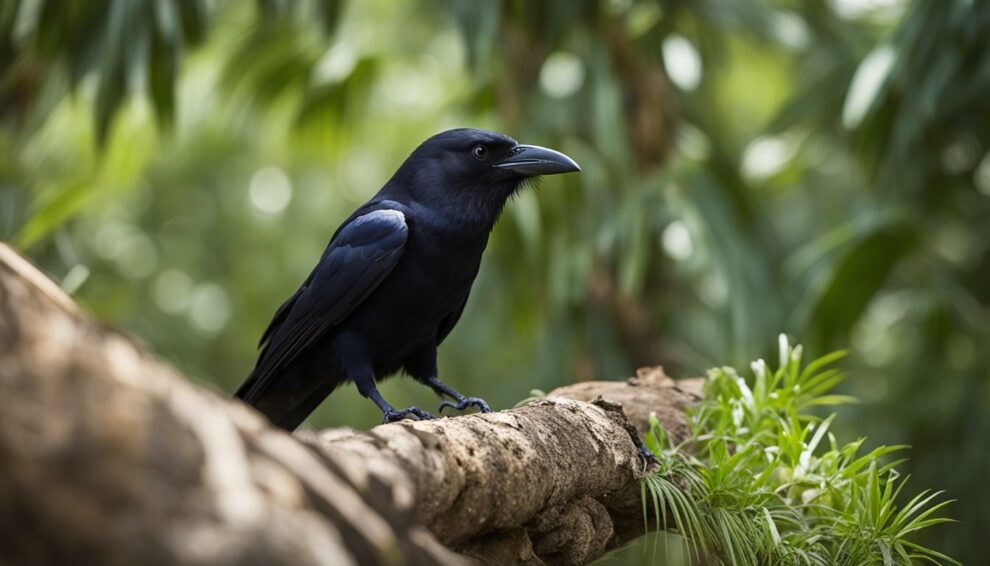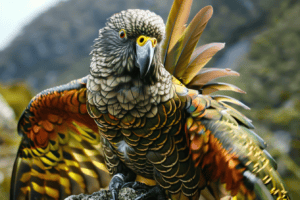The New Caledonian crow is a mastermind of the bird world when it comes to using tools.
Perched on the sun-dappled branches of New Caledonia’s dense forests, these black-feathered birds showcase their smarts by skillfully manufacturing and wielding sticks to forage for food.
This isn’t just random pecking; it’s a carefully thought-out process that reveals remarkable problem-solving skills.
With their knack for using twig tools to extract insects and other delicacies from tight crevices, these crows give us a glimpse into the sophistication of their intelligence, defying the age-old belief that tool use is a trait exclusive to humans.

Imagine you’re an adventurer, trailing through the lush, green canopies of the island.
Suddenly, you spot a crow artfully bending a twig with its beak, crafting it into a hook.
This isn’t just any play; this is a purpose-driven act of invention, a trait once thought to be uniquely human.
Scientists are intrigued by such displays of cognition and have observed that these tools are not just a fluke—they are a passed-down tradition, like recipes in a family cookbook.
What could possibly drive these winged whizzes to become such proficient tool users? The answer lies in their environment.
To feast on the hidden larvae in deadwood or among the foliage, these birds have had to evolve not just the right tools, but also the ingenuity to use them effectively.
In the process of understanding the crow’s behavior, we’re learning more about the fundamentals of cognition across all species, and these insights can reshape our understanding of intelligence in the animal kingdom.
As they go about their day, the New Caledonian crows are not just surviving; they’re revealing the complexities and capacities of avian brains, reminding us of the amazing ways wildlife adapts and thrives.
The Wonders of the New Caledonian Crow
Exploring the New Caledonian crow’s world, where unique bill shapes and impressive brainpower come together, offers a glimpse into one of nature’s most intriguing avian intellects.
Distinctive Physical Characteristics
The New Caledonian crow stands out from its peers not only for its tool-making proficiency but also for its distinct physical adaptations.
Its bill is an oddity – wedge-shaped and unlike that of any other crow – which works in tandem with its tool use.
When you picture the crow, imagine it skillfully wielding sticks with this unusual beak, teasing out insects from their hiding spots in wood.
It’s this specific beak shape that underscores the crow’s reputation as an evolutionary enigma, fine-tuned through ages for a life of crafting and utilizing tools.
Cognitive Capabilities and Problem Solving
Embarking on a journey through the mind of a New Caledonian crow reveals an intricate tapestry of cognitive processes.
These birds showcase a remarkable understanding of cause and effect, often seen bending twigs into hooks without any trial and error – a clear indication of planning and insight rare among non-human species.
Their neurological capacities allow them to solve complex problems that stump many other animals.
Have you ever wondered what it takes to extract a beetle larva from deep within a tree trunk?
Well, these crows have it figured out, using their homemade tools with precision that would make a locksmith proud.
This isn’t just mimicry; it’s a sign of genuine intelligence and creativity, traits that solidify their status as the avian equivalents of master inventors.
Master Craftsmen: Tool Behavior and Innovation

Delve into the world of the New Caledonian crow, where intelligent tool use isn’t just about survival; it’s an art.
These birds don’t just use tools; they craft them with precision and foresight seen in very few other species.
Advanced Tool Making Techniques
Imagine being able to fashion a hook from a splinter of wood or bend a twig to scoop insects from tree bark.
That’s just a regular day for the New Caledonian crow.
They are known to modify twigs and leaves and even craft complex tools that are tailored to specific tasks.
Their tool-related behavior includes stripping twigs of leaves and creating barbed hooks to probe for grubs.
Tool Use in Daily Life
Everyday challenges in the wild turn into opportunities for these crows to showcase their practical intelligence.
Using their beaks and feet, they manipulate their self-made tools to access food that would otherwise be unreachable.
Picture the crow as a tiny artisan, using its bill as a pair of workshop pliers to pinch, shape, and carve its materials into the perfect instruments of nourishment.
Comparing Crow and Primate Intelligence
It’s tempting to compare the New Caledonian crow’s tool use to that of primates, including chimpanzees.
Both display tool innovation and use, which is a mark of complex cognitive abilities.
Unlike many primates though, crows routinely show an ability to understand and manipulate their environment in ways that suggest a comparative level of cognition.
They do more than use tools; they anticipate the needs of future tasks, hinting at a forward-thinking mindset.
As you read about their tool-related behavior and innovative tool manufacture, ponder this: what does the crow’s ingenuity tell us about intelligence in the animal kingdom?
Could their problem-solving skills teach us something new about our own creativity?
The New Caledonian crow might just be the key to expanding our understanding of comparative cognition in the natural world.
Learning and Culture Among Crows

In the verdant forests of New Caledonia, crows are not just birds; they’re innovators and social learners.
With an outstanding ability to use tools and an intricate learning system, these avian scholars show us that culture is not solely a human trait.
Social Transmission and Learning
Imagine you’re a young New Caledonian crow. You’re born into a world where your elders are masters at making tools.
They can shape twigs into hooks and leaves into spears, all to snag those yummy treats that are just out of reach.
But how do you learn these nifty tricks?
Social transmission is the key. This is just a fancy way of saying that these crows learn from one another.
When observing their feathered friends and family, these savvy birds take mental notes on how to craft and use tools—a process mirroring the way children learn from their parents.
In the natural populations of these crows, tool designs vary, suggesting that different crow communities have distinct ‘cultural’ practices.
That’s right, just like us, they have their own local customs when it comes to tool-making.
Researchers suspect that genetic predispositions may give these crows a mental push towards tool use, but it’s the social learning that really turns them into tool-making connoisseurs.
Individual Versus Social Learning
So, you’ve seen your crow peers make tools, but do you copy them line for line, or do you add your own flair?
It turns out that individual learning plays a significant role side by side with social learning.
Rather than mimicking actions exactly, New Caledonian crows appear to understand the goal behind the tool usage and develop their own methods to achieve similar results.
This suggests a blend of individual experimentation and social observation.
In essence, while one crow might get an idea from watching another, it doesn’t mean they’ll forgo their own inventiveness.
Each crow’s personal experience and experimentation fine-tune their craftiness.
It’s like if you watched a friend build a sandcastle and decided to build your own but with a twist—you decide to make the highest tower ever!
Through their remarkable tool use, New Caledonian crows exemplify a complex interplay of social and individual learning.
These birds show us that intelligence and culture are themes of the natural world that extend far beyond humanity.
They remind us to look up to the treetops, where feathery geniuses stretch the boundaries of what we thought we knew about animal intelligence and learning.
Frequently Asked Questions

The New Caledonian crow exhibits remarkable intelligence through its use of tools.
These sophisticated behaviors reveal much about their cognitive abilities.
Here, we explore common inquiries about these intriguing birds and their exceptional use of tools.
How do New Caledonian crows craft tools to find their food?
New Caledonian crows demonstrate ingenuity by fashioning sticks into hooks and other shapes to extract insects and other food from tight spaces.
They select the appropriate materials from their environment and skillfully modify them according to the task at hand.
Can you describe how crows use objects they find in nature to assist them?
Certainly! These clever birds utilize twigs, leaves, and even their own feathers as tools.
They might use a twig to poke at insects in a log or fashion a leaf into a kind of spoon for sipping up water.
What makes the tool-using abilities of New Caledonian crows unique among birds?
What’s truly unique about the New Caledonian crow is its ability to create tools with specific designs, like hooks, which are not commonly observed in other bird species.
Their strategic use of these tools to access hard-to-reach food sets them apart.
Could you explain what scientists have learned about the cognitive abilities of crows from their tool use?
Researchers have discovered that these crows possess problem-solving skills and the understanding of cause-and-effect relationships, indicative of advanced cognitive abilities.
Their tool-making and using behaviors suggest a high level of intelligence akin to that seen in primates.
In what ways do the tools created by New Caledonian crows differ from those used by other species?
The tools crafted by New Caledonian crows are often elaborate, with birds creating barbed hooks out of branches, unlike the simpler objects used by other species.
They showcase a level of precision and forethought indicative of complex cognitive processes.
How has the discovery of tool use in New Caledonian crows changed our understanding of animal intelligence?
The New Caledonian crow’s tool-using ability has broadened our perspectives on the intellectual capabilities of animals.
It has challenged the notion that sophisticated tool use is exclusive to humans, fostering a greater appreciation for the intelligence found in the animal kingdom.









